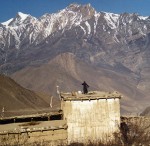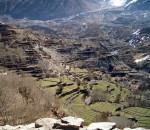








The ProjectBroadening of the project As the amount of donations had increased enormously in the winter 2006/2007, after 12 years of work in Eritrea we started a similar project in the Himalayas in the summer of 2007. We chose the Himalayas because there many single mothers are also living under very difficult – often degrading – circumstances in remote villages and because this region is especially hard hit by climate change. On 17 June 2007, the articles of association and our name were changed accordingly and we have found an experienced and in the Himalayas well connected partner, Sahayog Himalaya-Nepal. I shall be visiting the Nepal project once a year (privately financed). As always, we will put the travel reports on our homepage and mail them to you together with the donation receipts. Due to the monsoon season or snow bound pass routes during winter, visits to the different regions will have to take place at different months. Consequently, travel reports and donation receipts will in future be sent out sometimes in the summer and sometimes in the autumn. Receipts for donations received in the second half of the year will be sent out in January of the following year. The living conditions in the Himalayas Living conditions in the far flung villages of the Nepalese Himalayas are rapidly changing. Many men leave the villages looking for work in tourism or in the city. Road construction eases migration into cities. The women, children and the elderly stay behind in a region where survival, even for intact families, is very hard work. Farming and animal husbandry remain the basis for a livelihood in villages away from the trekking areas. Terraced fields have to be maintained on steep mountainsides. This is very hard work indeed. Fire wood is sparse and only used for cooking, not heating. Occasionally, one can observe women dragging a heavy log up an 800 – 1000 metres difference in altitude. Instead of wood, most women collect dung for fuel in large baskets. However, this leads to further depletion of the soil. Branches, leaves and straw for animal feed – all are transported by women in giant bundles on narrow mountain trails. Due to the glacier melt there is plenty of water, but that also must be transported by women. Single mothers especially need the help of their daughters and cannot send them to school. Conquering poverty with the help animals The project aims to provide single mothers with the opportunity to find their own way out of poverty. Thus, we mainly allocate milking animals in the Himalayas: cows, in lush regions water buffalo and – at high altitudes – nak (female yak). These provide milk, yoghurt, cheese and ghee (a durable fat made from clarified butter) which are good sources of nutrition for the family and can create a reasonable income. Additionally, we allocate female donkeys to help women carry loads, make them more mobile and to create new sources of income. However, the purchase of donkeys can be problematic in some regions. The women receive female animals which will produce offspring. For ecological reasons, we do not allocate goats. In Nepal, we give animals only to single mothers and grandmothers who look after school-going children and who live in remote areas. Number of children and level of poverty are decisive criteria for allocation. In most cases, local mother’s organisations help with the selection of women. A secure economic livelihood can protect the mother and daughters against trafficking in women, which is targeting these mountain villages. Whenever possible, animals are purchased locally. If no suitable cows – e.g. cows with sufficient milk yield - are available in the region, cows or water buffalo are purchased elsewhere and transported to the area. Sahayog Himalaya-Nepal ensures that the respective cross breed of animal will be able to withstand altitude, winter climate and available fodder. Animals are purchased regionally and given to the women for free in the presence of a local dignitary. There are 21 doctors for 100,000 people – in the sparsely populated high mountain areas this means that many people have no access to medical treatment. For every 100,000 births, 740 women die (in Germany, the number is 8). This is why midwives and female amchis (doctors of traditional Tibetan medicine) will be supplied with small indigenous horses (approx. 1.4 m hh). Living with climate change In the Himalayas, the effects of climate change are dramatic making the lives of these women harder all the time. Globally, the atmosphere has warmed by 0.8 degrees Celsius, but at an altitude of 4000 this is 0.12 degrees Celsius annually. The glacier melt has made mountain streams more dangerous. In other regions, heavy rains cause landslides on eroded mountainsides, threatening villages, terraced fields and mountain trails and bridges which had been used for centuries. What had been established over generations must be rebuilt without help. This is hard and often dangerous work for which there are less and less men remaining in the villages to help the women. In some regions, rains have been decreasing for several years. Since the seasons are no longer dependable, harvests have become unreliable. Due to the shorter summers, a delay in spring or rain is far more disastrous in the Himalayas than here in Europe. Less rain means also even less grass. The number of goats in the harsher regions in the north is very high as these animals are comparably cheap and provide a good income from the sale of wool. However, the goat herds are overgrazing the hillside meadows, they tear out grass and other plants with roots since they are able to digest both. As a result, erosion on the hill sides is increasing. – Cows and nak, which eat only the green and leave the roots in the soil, are much more expensive and prohibitive for many. Only we high energy users in developed countries are able to reduce climate change, not the people of the Himalayas. Therefore, it is even more urgent to enable single mothers now to conquer this extreme poverty. People who have to focus all of their energy to secure good, shelter and clothing for day to day survival are often forced to exploit nature, be it with goats or, for example, excessive harvesting of profitable medicinal plants such as the Tibetan caterpillar fungus Cordyceps sinensis (on the IUCN Red List). Those living in extreme poverty have neither the time nor the energy to improve the environmental conditions for future generations. Once the single mothers have established a secure income for themselves, they can start to improve the ecological situation, e.g. through sustainable harvest of medicinal plants or to at least attenuate the threats of climate change at high altitudes. Of specific importance is stabilisation of the soil, by cultivating grass, shrubs or trees, preferably plants which can feed humans and animals. Sea buckthorn, apple or apricot trees are also a source of vitamins and can provide an income through the sale of dried fruit and other produce. In future years, when the single mothers have improved their economic situation with the help of cows, nak, water buffalo or donkey, we intend to include ecological aspects in the project. Pollarding is a traditional method of woodland management in many Himalayan regions which must be reintroduced around the villages: The tree stem is cut off about two meters above ground level and only the newly grown branches are harvested. In this way, the tree roots remain durable and strong. This ancient method of sustainable woodland use saves the women from time and energy intensive search for dung. Another future project aim is training the women in the building of energy efficient stoves. Some of the wealthier people already own these stoves with inbuilt hot water tank. Many of the poor however use clay stoves without flues or vents to regulate air inflow and reduce wood use. During cooking the entire room fills with noxious smoke. |

Many of the men migrate to the cities; the women with
their children stay behind in the villages and have to do all the work.
The women and girls transport water, wood, dung, leaves and other animal
feed on their backs for storage on the roofs or in barns.

A village in Upper Mustang, altitude above 4000 m:
terraced fields stretch down to the Kali Gandaki river.

Sustainable wood harvest around the village: Tree trunks remain,
only shoots are harvested. In this way, the tree roots maintain the durability of the soil.
home | the projects | news | on tour | on site | ideas | partners | the board | help | mail
Account No. 106 57575 - Sparkasse KölnBonn - BLZ 370 501 98
For donations from outside Germany - IBAN: DE02 3705 0198 0010 6575 75 - Swift-BIC: COLSDE33
please only bank transfers in Euro, no checks!